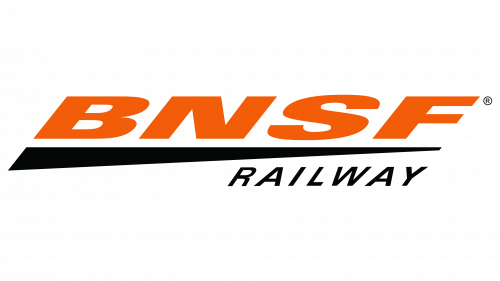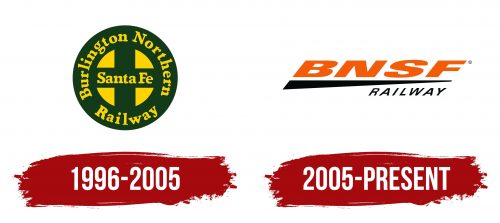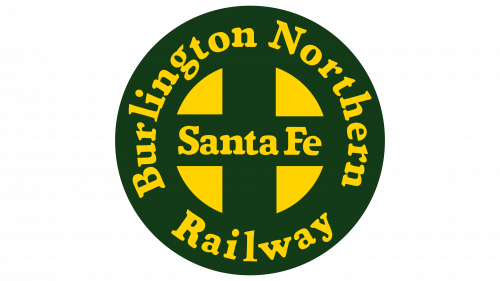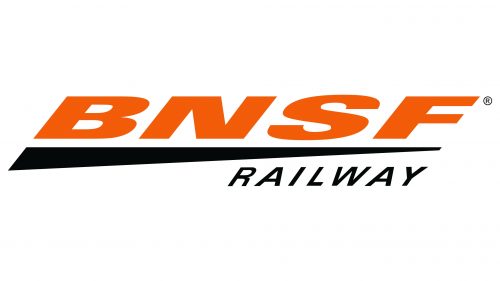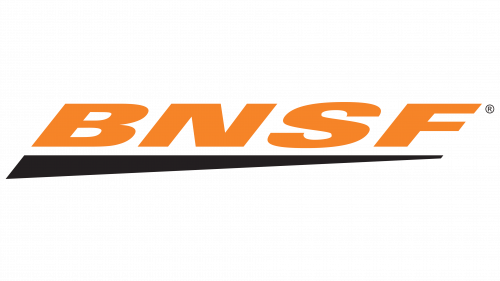The BNSF Railway logo reflects the power and reliability of the company, which is a leader in the field of rail transportation. The sharp lines and contrasting colors convey a commitment to innovation, highlighting a progressive approach to developing the transportation infrastructure in the United States.
BNSF Railway: Brand overview
Although BNSF Railway’s history started with a significant merger in 1995, the company’s origins are far more deeply ingrained in American railroad history. Several older railroad firms, including the Great Northern Railway, Northern Pacific Railway, Chicago, Burlington and Quincy Railroad, Spokane, Portland, and Seattle Railway, merged to establish Burlington Northern (BN) in 1970. These businesses all had lengthy histories that began in the middle of the 1800s.
James J. Hill established the Great Northern Railway in 1889; it was dubbed “Hill’s Empire” and was crucial to the growth of the American Northwest. The United States’ first northern transcontinental railroad was the Northern Pacific, which was granted a charter by Congress in 1864.
On the other hand, the Atchison, Topeka, and Santa Fe Railway (ATSF), established in 1859 and subsequently joined the Santa Fe Pacific Corporation, was crucial to the growth of the American Southwest. Among the well-known passenger trains operated by ATSF was the “Super Chief,” which connected Chicago and Los Angeles.
Burlington Northern and Santa Fe Pacific Corporation underwent a historic merger on September 23, 1995, which created Burlington Northern Santa Fe Corporation (BNSF), after this merger, which included 28 US states and two Canadian provinces, one of the biggest railroad networks in North America was formed.
Following the merger, the firm started to combine the two enormous railroad networks. This includes developing a unified company culture, merging dispatching systems, and standardizing operating practices. The entire completion of this intricate operation took several years.
1996, the company ordered 350 new locomotives from General Electric and Electro-Motive Diesel for a significant fleet renovation project. This order, representing the company’s goals to update its infrastructure, was the largest single locomotive order in American railroad history.
By opening the Network Operations Center in Fort Worth, Texas, in 1999, the enterprise made a big step toward digitizing its operations. This facility greatly increased operational efficiency by centralizing train movement management throughout its network.
The firm made large infrastructural improvements during the 2000s. In 2006, it stated that it would spend $2.4 billion on network upgrades, including modernizing signaling systems and increasing capacity on important routes.
The company’s purchase by Warren Buffett’s investment behemoth, Berkshire Hathaway, in 2010 marked a significant turning point in the company’s history. The $44 billion transaction represented Buffett’s faith in the railroad industry’s long-term prospects and was the largest in Berkshire Hathaway’s history.
After acquiring Berkshire Hathaway, the company continued investing in its technology and infrastructure. In 2013, the business declared it would spend $4.1 billion on expanding its network, including constructing new lines and modernizing old ones.
The firm started testing LNG-powered locomotives in 2014, a significant step in lowering emissions and increasing operational effectiveness.
In 2015, the company celebrated its 20th anniversary of founding. With a network covering more than 32,000 miles, the firm had grown to become one of North America’s biggest freight railroad companies by this point.
2016 the brand invested more in safety technology, starting a network-wide Positive Train Control (PTC) rollout. This system aims to prevent human error-related accidents, such as train collisions.
Regarding freight volume, 2018 was a record year for the enterprise. More than 10 million carloads of freight were moved by the company, demonstrating both the expansion of the US economy and the effectiveness of its operations.
In 2019, the firm announced plans to invest $3.57 billion in network modernization and development as part of its ongoing infrastructure initiatives. This includes initiatives to modernize bridges and tunnels and expand capacity in important routes.
In 2020, the company continued its investments in infrastructure and technology. The firm invested significantly in modernizing its network, including upgrades to tracks, bridges, and signaling systems. Special attention was given to implementing advanced technologies to enhance safety and operational efficiency. The enterprise also expanded Positive Train Control (PTC) across its entire network, significantly improving rail transport safety.
In 2021, the firm announced major investments in the development of intermodal transportation. The company began constructing a new intermodal facility in Barstow, California, to improve connectivity between Southern California ports and inland U.S. markets. This project reflects the company’s strategic vision to strengthen its position in container transport and optimize supply chains. That year, the enterprise also continued its efforts to improve environmental efficiency. The company expanded the use of low-emission locomotives and began testing alternative fuel technologies, including biodiesel and hydrogen fuel cells.
In 2022, the firm launched a pilot project using autonomous locomotives on certain sections of its network. This project aimed to explore the potential of automation to enhance the efficiency and safety of rail operations. The company also invested in developing artificial intelligence systems to optimize route planning and cargo management.
In 2023, the enterprise announced a major program to upgrade its locomotive fleet. This program includes acquiring new, more environmentally friendly locomotives and modernizing existing ones to reduce emissions and improve fuel efficiency. The company also expanded its training and development programs, focusing on preparing specialists in new technologies.
Throughout this period, the company continued to play a key role in the U.S. economy, ensuring the efficient transportation of goods across the country.
Meaning and History
What is BNSF Railway?
It is one of the largest freight railroad networks in North America. It operates approximately 32,500 miles of track in 28 states and three Canadian provinces. The company is a critical component of the U.S. transportation infrastructure, moving a wide range of goods, including agricultural products, coal, manufactured goods, and consumer goods. It is a Berkshire Hathaway, Inc. subsidiary owned by Warren Buffett.
1996 – 2005
The early BNSF Railway logo was based on the Atchison Topeka and Santa Fe Railway emblem, from which designers borrowed the round shape, central cross, and the bold serif “Santa Fe” lettering. There are several differences between them, of course.
In the new version, the circle has a wide border containing the text “Burlington Northern Railway.” The words are arranged in a ring and use the same font as the central inscription. Slanted tops on the letters “r,” “l,” “i,” “n,” and “t” add dynamism to the emblem, showing its connection to rail transportation. This embodies the energy of freight trains traveling along the three transcontinental routes linking the western and eastern United States.
The long serifs enhance the visual movement, aiming to draw attention to the logo and make it recognizable. At the same time, rounded lines and softened letter corners create an illusion of safety, encouraging customers to entrust BNSF with their cargo confidently.
The negative space between four yellow triangles forms the central cross, creating a circle-like shape. The two perpendicular lines may signify the intersection of rail tracks or the crossing of railways and roads. This symbol emphasizes the importance of the transportation infrastructure, which connects cities across North America like arteries. The cross thus represents the integrity of various parts of the railway system.
The round shape resembles a wheel, another nod to the brand’s connection with trains. It can also represent a heraldic shield, highlighting BNSF’s roots and traditions. The shield, as a symbol of protection and reliability, indicates that the carrier ensures the safety of the cargo.
The emblem’s base is dark green, associated with professionalism, stability, and reliability. The lettering uses yellow, symbolizing energy and optimism. These colors are taken from the logos of the railroad companies that merged in 1996 to form BNSF Railway. Historically, yellow represents the Atchison, Topeka, and Santa Fe Railway, while dark green represents Burlington Northern Railroad.
2005 – today
As part of its tenth-anniversary celebration, Burlington Northern and Santa Fe Railway changed its name to BNSF Railway and updated its logo to reflect its years of progress. Moving away from the round shield, the company opted for a sleek geometric style with predominant straight lines and angles.
The central element of the new identity is a tapering black stripe resembling a long horizontal triangle. Due to its elongated pointed shape and angled edge, it appears dynamic, like a flying arrow. The speed line symbolizes several concepts:
- The swift movement of trains speeding along the tracks.
- The efficiency of the railways in providing fast delivery of goods across the country.
- The continuous development of the company is aimed at improving service quality.
The line highlights the orange abbreviation “BNSF,” and below it, in the bottom right corner, is the black word “RAILWAY.” Both inscriptions use a modified Univers family font, with the first in bold and the second in thin. The elegant italic reflects the freight carrier’s pursuit of excellence and order. The slightly compressed slanted letters enhance the logo’s dynamism, emphasizing the importance of rail communication, which makes the delivery of coal, oil, grain, and other goods fast.
Orange is used as a color accent to draw attention to the keyword in the company’s name. Its presence adds a burst of energy to the logo, reflecting BNSF’s active stance in the transportation industry. Black creates an attractive visual contrast, as it is associated with strength, authority, and a classic style.
